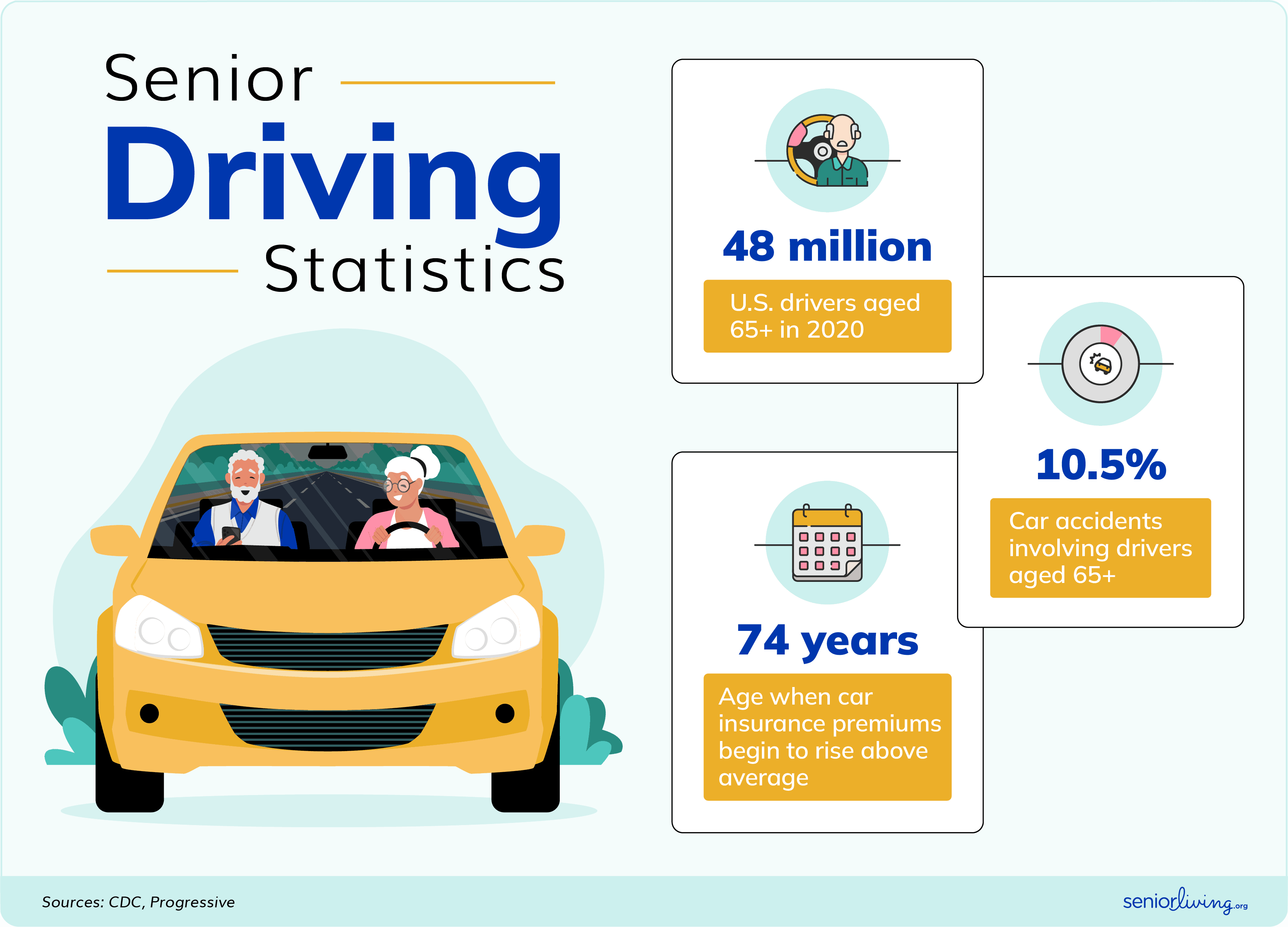Senior Driving Statistics
SeniorLiving.org is supported by commissions from providers listed on our site. Read our Editorial Guidelines
Senior Driving Statistics: Key Takeaways
- There are more senior drivers on the road than ever before.
- Drivers in their 30s are far more likely to get in accidents than drivers over 65.
- People over 74 tend to pay higher car insurance rates than most other age demographics.
- Most seniors stop or reduce their driving by their mid-70s.
Car accidents involving older adults have risen in recent years, partly because there are simply more senior drivers on the road. In 2020, the United States had a total of 48 million drivers over the age of 65 — a 68 percent increase since the year 20001. However, there are a lot of misconceptions surrounding senior drivers and the risks they pose to themselves and others. The fact is that younger drivers are actually more likely to be involved in both fatal and non-fatal accidents than older drivers, but there are a lot of caveats and factors to consider when evaluating the link between age and safety on the road.
In this guide, we’ll take a closer look at senior driving and provide some of the most important facts and statistics.
Overview of Senior Driving Statistics
Now that the Baby Boomer generation has reached retirement age, there are more senior drivers than ever before. According to the U.S. Department of Transportation, there are 37.2 million licensed drivers who are 60 years of age or older. About 51 percent of these license holders are female, though men tend to continue driving for longer.
Having a license does not necessarily mean that all of these drivers are regularly out on the road. With age, many older adults cut down on their driving, frequently out of necessity. Older adults are also less likely to drive at night or during inclement weather2. On average, about 88 percent of men with a driver’s license continue to drive in their early 70s, while that figure drops to 55 percent among men who are 85 or older. Only 70 percent of women in their early 70s continue driving, and that figure drops to just 22 percent once they reach 853.
Driving Statistics by Age Group
Though many people stereotype older drivers as being a “danger” on the road, research says otherwise. According to the National Safety Council, people between the ages of 25 and 34 are nearly seven times more likely to be involved in an accident than those age 75 and above4. The table below shows a more in-depth breakdown of driving statistics and accidents by age:
| Age group | Drivers in fatal accidents in 2021 | Percentage of drivers in fatal accidents | Drivers in all accidents | Percentage of drivers in all accidents | Number of accidents per 100,000 license holders |
|---|---|---|---|---|---|
| Under 16 | 200 | 0.30% | 130,000 | 0.60% | N/A |
| 16 to 19 | 4,200 | 6.30% | 2,190,000 | 9.30% | 25,890 |
| 20 to 24 | 7,600 | 11.40% | 3,180,000 | 13.50% | 18,235 |
| 25 to 34 | 15,000 | 22.50% | 5,340,000 | 22.60% | 13,133 |
| 35 to 44 | 11,600 | 17.40% | 4,120,000 | 17.50% | 10,413 |
| 45 to 54 | 9,900 | 14.90% | 3,350,000 | 14.20% | 8,947 |
| 55 to 64 | 9,100 | 13.70% | 2,830,000 | 12% | 7,143 |
| 65 to 74 | 5,400 | 8.10% | 1,670,000 | 7.10% | 5,380 |
| 75 and above | 3,700 | 5.60% | 800,000 | 3.40% | 4,311 |
As you can see from the table above, seniors age 65 and above account for 13.7 percent of fatal accidents and 10.5 percent of all accidents. Both figures are low compared to drivers age 25 to 34, who account for 22.5 percent of fatal accidents and 22.6 percent of all accidents. However, seniors who get in an accident are more likely to experience fatal injuries because they are often more susceptible to injuries in general.
Car Insurance Rates
Despite the fact that younger drivers are more likely to get into an accident, older seniors often have to pay higher auto insurance premiums. However, rate increases are closely linked with the risk of injury, and accidents in general. According to Progressive’s internal data, adults between the ages of 55 and 64 often pay the lowest premiums — as much as 10 percent lower than the national average. Drivers between the ages of 65 and 74 pay only 3 percent less than the average, while drivers over the age of 74 pay roughly 4 percent more than the average5.
Did You Know? Some states mandate car insurance discounts for seniors who complete driving safety courses offered by organizations like AARP, AAA, and the National Safety Council.
Determining insurance rates by age can be tricky, as younger drivers are more likely to engage in risky behaviors like speeding, driving while intoxicated, and driving without wearing a seatbelt6. Middle-aged drivers are generally seen to be the lowest risk to insurance carriers, as they often have years of driving experience, are less likely to engage in risky behaviors, and often have not developed significant hearing loss or vision problems. Premiums rise for many older adults, particularly those over the age of 74, because they are more likely to have vision and hearing impairments, cognitive decline, and slowed reflexes, despite being the demographic least likely to purposefully engage in risky driving behaviors.
State Requirements for Senior Drivers
Each state has its own rules related to driver’s license renewals for people of all ages. Many states require older adults to get renewals and undergo vision tests more frequently to ensure that they are capable of driving safely. However, the connection between driver’s license renewal requirements and senior accidents is not always cut and dried. You can see evidence of this in the tables below, which feature states with the highest and lowest rates of senior car accidents.78
States With the Highest Rates of Fatal Senior Accident
| State | Fatal senior accidents per 100,000 license holders | Renewal period for general population | Renewal period for older adults | Proof of adequate vision |
|---|---|---|---|---|
| Wyoming | 24.69 | 5 years | 5 years | Required for all ages at each renewal |
| Arkansas | 24.23 | 8 years | 4 or 8 years (70 and above) | Required for all ages at every other renewal |
| Kansas | 23.5 | 6 years | 4 years (65 and above) | Required for all ages at each renewal |
| North Dakota | 23.17 | 6 years | 4 years (78 and above) | Required for all ages at each renewal |
| Kentucky | 22.77 | 4 or 8 years | 4 or 8 years | Required for all ages at each renewal |
States With the Lowest Rates of Fatal Senior Accidents
| State | Fatal senior accidents per 100,000 license holders | Renewal period for general population | Renewal period for older adults | Proof of adequate vision |
|---|---|---|---|---|
| Washington | 8.13 | 6 or 8 years | 6 or 8 years | Required for all ages at each renewal |
| Massachusetts | 8.8 | 5 years | 5 years | Required at each renewal (78 and above) |
| Rhode Island | 8.8 | 5 years | 2 years (78 and above) | Required for all ages at each renewal |
| Minnesota | 9.81 | 4 years | 4 years | Required for all ages at each renewal |
| New Jersey | 9.99 | 4 years | 2 or 4 years (70 and above) | Required for all ages every 10 years |
Tips for Staying Safe on the Road
Regardless of your age, you should always do everything possible to stay safe on the road. Here are some of our tips for older adults and their families to drive safely:
- Always wear a seatbelt.
- Avoid driving while distracted.
- Drive when conditions are safest (daytime and clear weather).
- Never drive after drinking or taking medication.
- Keep a safe distance from other drivers.
- Plan your route ahead of time.
For more in-depth tips and strategies, check out our guide on safety tips for senior drivers.
Frequently Asked Questions About Senior Drivers
-
Which age group causes the most fatal car accidents?
Drivers between the ages of 30 and 39 are responsible for the most fatal car accidents each year.
-
At what age do most seniors stop driving?
The age to stop driving varies from one person to the next, though many seniors stop driving (or consider the possibility) in their mid-70s.
-
Is it safe for 80-year-olds to drive?
It depends on the health and motor skills of the driver, but many 80-year-olds are perfectly capable of driving safely.
-
At what age do driving skills decline?
Most people will not begin to see their vision and motor skills decline substantially until their mid-70s. At this point, many seniors will see their driving skills start to decline.
Are you a journalist or researcher looking for data or expertise? See our open data portal, or reach out to us at open-data@seniorliving.org to connect with an expert on aging in America.
CDC. (2022). Older Adult Drivers.
IIHS. (2022). Older Drivers
National Library of Medicine. (2002). Driving Life Expectancy of Persons Aged 70 Years and Older in the United States
NSC.org. (2023). Age of Driver
Progressive. (2023). Auto insurance for seniors
CDC. (2023). Teen Drivers and Passengers: Get the Facts
NHTSA. (2023). Traffic Safety Facts
IIHS. (2023). License renewal procedures


